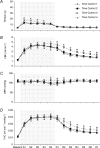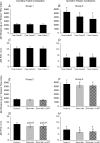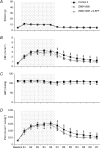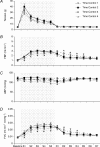Elucidation in the rat of the role of adenosine and A2A-receptors in the hyperaemia of twitch and tetanic contractions
- PMID: 19204055
- PMCID: PMC2678226
- DOI: 10.1113/jphysiol.2008.163683
Elucidation in the rat of the role of adenosine and A2A-receptors in the hyperaemia of twitch and tetanic contractions
Abstract
Adenosine is implicated in playing a role in blood flow responses to situations where O(2) delivery is reduced (hypoxia) or O(2) consumption is increased (exercise). Strong isometric contractions have been shown to limit vasodilatation, potentially leading to a greater mismatch between and than during twitch contractions. Thus, we hypothesized that adenosine makes a greater contribution to the hyperaemia associated with isometric tetanic than isometric twitch contractions and aimed to elucidate the adenosine-receptor subtypes involved in the response. In four groups of anaesthetized rats, arterial blood pressure (ABP), femoral blood flow (FBF) and tension in the extensor digitorum longus muscle were recorded; isometric twitch and tetanic contractions were evoked by stimulation of the sciatic nerve for 5 min at 4 Hz and 40 Hz, respectively. Groups 1 (twitch) and 3 (tetanic) were time controls for Groups 2 and 4, which received the selective A(2A)-receptor antagonist ZM241385 before the third and 8-sulphophenyltheophylline (8-SPT; a non-selective adenosine receptor antagonist) before the fourth contraction. Time controls showed consistent tension and hyperaemic responses: twitch and tetanic contractions were associated with a 3-fold and 2.5-fold increase in femoral vascular conductance (FVC, FBF/ABP) from baseline, respectively. ZM241385 reduced these responses by 14% and as much as 25%, respectively; 8-SPT had no further effect. We propose that, while twitch contractions produce a larger hyperaemia, adenosine acting via A(2A)-receptors plays a greater role in the hyperaemia associated with tetanic contraction. These results are considered in relation to the A(1)-receptor-mediated muscle dilatation evoked by systemic hypoxia.
Figures







Similar articles
-
Nitric oxide (NO) does not contribute to the generation or action of adenosine during exercise hyperaemia in rat hindlimb.J Physiol. 2009 Apr 1;587(Pt 7):1579-91. doi: 10.1113/jphysiol.2008.163691. Epub 2009 Feb 9. J Physiol. 2009. PMID: 19204054 Free PMC article.
-
Contribution of non-endothelium-dependent substances to exercise hyperaemia: are they O(2) dependent?J Physiol. 2012 Dec 15;590(24):6307-20. doi: 10.1113/jphysiol.2012.240721. Epub 2012 Oct 8. J Physiol. 2012. PMID: 23045341 Free PMC article. Review.
-
Ischaemic skeletal muscle hyperaemia in the anaesthetized cat: no contribution of A2A adenosine receptors.J Physiol. 1997 Apr 1;500 ( Pt 1)(Pt 1):205-12. doi: 10.1113/jphysiol.1997.sp022010. J Physiol. 1997. PMID: 9097944 Free PMC article.
-
Adenosine receptor subtypes and vasodilatation in rat skeletal muscle during systemic hypoxia: a role for A1 receptors.J Physiol. 1999 Jan 1;514 ( Pt 1)(Pt 1):151-62. doi: 10.1111/j.1469-7793.1999.151af.x. J Physiol. 1999. PMID: 9831723 Free PMC article.
-
Vasodilator interactions in skeletal muscle blood flow regulation.J Physiol. 2012 Dec 15;590(24):6297-305. doi: 10.1113/jphysiol.2012.240762. Epub 2012 Sep 17. J Physiol. 2012. PMID: 22988140 Free PMC article. Review.
Cited by
-
Adenosine receptor antagonist and augmented vasodilation during hypoxic exercise.J Appl Physiol (1985). 2009 Oct;107(4):1128-37. doi: 10.1152/japplphysiol.00609.2009. Epub 2009 Aug 6. J Appl Physiol (1985). 2009. PMID: 19661449 Free PMC article. Clinical Trial.
-
Effect of extraluminal ATP application on vascular tone and blood flow in skeletal muscle: implications for exercise hyperemia.Am J Physiol Regul Integr Comp Physiol. 2013 Aug 1;305(3):R281-90. doi: 10.1152/ajpregu.00189.2013. Epub 2013 Jun 12. Am J Physiol Regul Integr Comp Physiol. 2013. PMID: 23761642 Free PMC article.
-
Nitric oxide (NO) does not contribute to the generation or action of adenosine during exercise hyperaemia in rat hindlimb.J Physiol. 2009 Apr 1;587(Pt 7):1579-91. doi: 10.1113/jphysiol.2008.163691. Epub 2009 Feb 9. J Physiol. 2009. PMID: 19204054 Free PMC article.
-
Contribution of non-endothelium-dependent substances to exercise hyperaemia: are they O(2) dependent?J Physiol. 2012 Dec 15;590(24):6307-20. doi: 10.1113/jphysiol.2012.240721. Epub 2012 Oct 8. J Physiol. 2012. PMID: 23045341 Free PMC article. Review.
-
Effects of modest hyperoxia and oral vitamin C on exercise hyperaemia and reactive hyperaemia in healthy young men.Eur J Appl Physiol. 2015 Sep;115(9):1995-2006. doi: 10.1007/s00421-015-3182-0. Epub 2015 May 12. Eur J Appl Physiol. 2015. PMID: 25963380 Clinical Trial.
References
-
- Belloni FL, Phair RD, Sparks HV. The role of adenosine in prolonged vasodilation following flow-restricted exercise of canine skeletal muscle. Circ Res. 1979;44:759–766. - PubMed
Publication types
MeSH terms
Substances
Grants and funding
LinkOut - more resources
Full Text Sources

